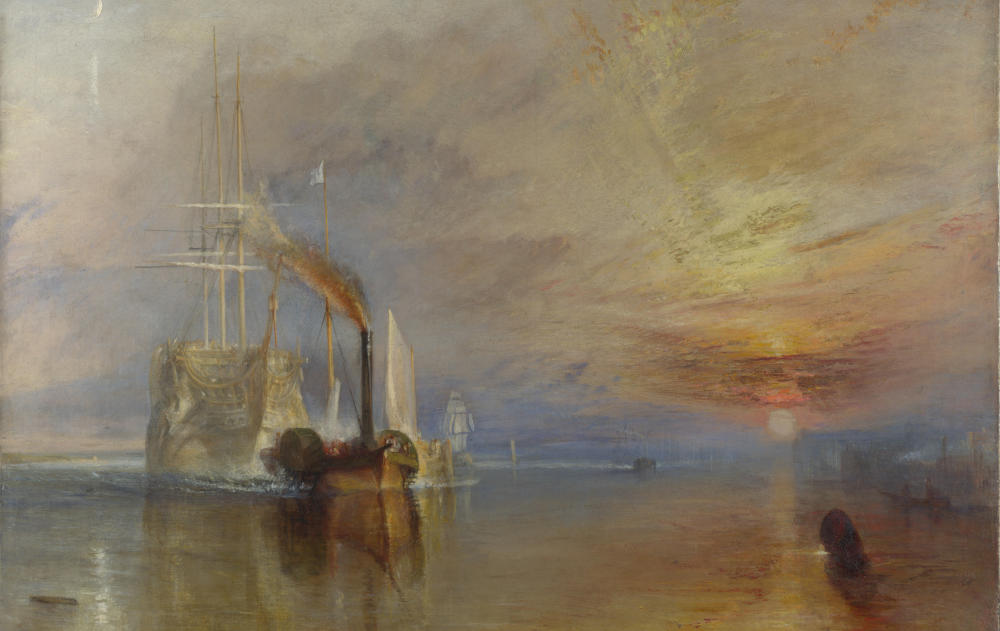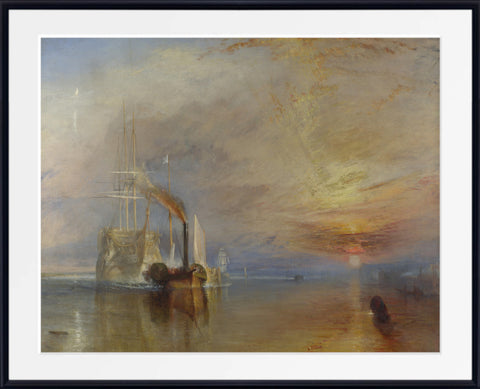Table of Contents:[hide]
The Fighting Temeraire - Summary
"The Fighting Temeraire, Tugged to Her Last Berth to be Broken Up, 1838" is a masterpiece painted by the English artist Joseph Mallord William Turner in 1838. This oil-on-canvas painting portrays the HMS Temeraire, a formidable 98-gun ship that played a significant role in the Battle of Trafalgar. In the painting, the Temeraire is seen being towed up the Thames River in 1838 by a paddle-wheel steam tug, destined for its final resting place in Rotherhithe, where it would be dismantled for scrap.
Currently displayed in the National Gallery, London, the painting was generously bequeathed to the nation by the artist in 1851 as part of the Turner Bequest. In a poll conducted by BBC Radio 4's Today program in 2005, it was voted the nation's favorite painting. Notably, in 2020, it was featured on the new £20 banknote, alongside Turner's self-portrait from 1799.
Background to The Fighting Temeraire
At the pinnacle of his career, Joseph Mallord William Turner painted this iconic picture, showcasing his mastery after four decades of exhibiting at the Royal Academy in London. Turner was celebrated for his atmospheric paintings that delved into themes like weather, the sea, and the play of light. Being intimately familiar with the River Thames, he frequently depicted ships and waterfront scenes in both watercolors and oils. Turner, known for his meticulous preparatory sketches, refined his ideas into finished works within his studio.
While it remains uncertain whether Turner personally witnessed the towing of the Temeraire, historical accounts suggest he might have observed the event from various vantage points along the river. In the painting, Turner exercised considerable artistic freedom, imbuing the work with symbolic significance that resonated with his contemporary audience. At the age of twenty-eight, during the Napoleonic Wars, Turner, fueled by patriotism, created this masterpiece. The Temeraire, renowned for her valor at the Battle of Trafalgar, had recently been sold by the Admiralty, a subject that garnered substantial media attention and likely drew Turner’s interest. In a departure from reality, the painting shows the tug flying a white flag, indicating the ship's sale to a private company, rather than the iconic Union Jack.
Symbolism of The Fighting Temeraire
In this painting, the composition is notably unconventional. The central focus, the aging warship, is positioned towards the left, emerging majestically in ethereal hues against a backdrop of blue sky and rising mist. This creates a stark contrast with the grimy, soot-covered tugboat with its towering smokestack, disturbing the otherwise tranquil river surface.
The triangular expanse of blue sky frames a second triangle formed by distant masted ships, diminishing in size as they recede. The Temeraire and the tugboat have already passed a small river vessel, its sail barely catching a gentle breeze. Further down the river, a square-rigged ship sails with all its canvas stretched wide. Another small craft appears as a distant white speck. Far in the background, beyond a second approaching tugboat, a three-masted ship lies at anchor. These calm, motionless ships underscore the fading relevance of sail power.
On the painting's opposite side, at the same distance from the frame as the Temeraire's main mast, the sun sets above the estuary. Its rays reach into the clouds above and across the water's surface. The red hues of the clouds mirror the color of the smoke trailing from the tugboat. This sunset symbolizes the conclusion of an era, where steam power supersedes sail.
Behind the Temeraire, a slender crescent moon casts a beam across the river, signifying the dawn of a new industrial age. The primary theme of the painting revolves around the decline of heroic strength. Some interpretations suggest that the ship embodies the artist himself, reflecting on his accomplished past and contemplating mortality. Turner affectionately referred to the painting as his "darling."
Later, Sir Henry Newbolt captured this poignant scene in his ballad, "The Fighting Temeraire," immortalizing the ship's fading journey down the river: "And she's fading down the river, But in England's song forever, She's the Fighting Téméraire."
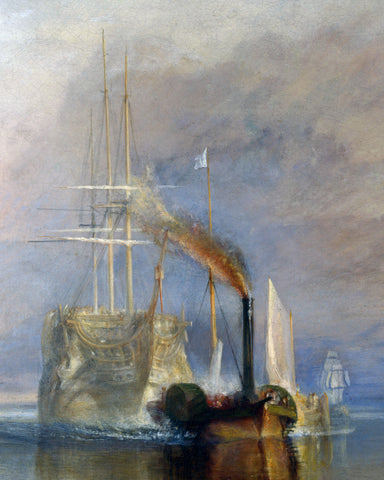
image: The Fighting Temeraire detail
William Turner - Artistic Licence
Turner exercised artistic freedom in his painting, deviating from certain factual details. The ship, affectionately known as "Saucy" to her crew, was referred to as the "Fighting Temeraire" in the artwork. Before being sold to the ship-breaker John Beatson, the vessel had been stationed at Sheerness Dockyard and was later relocated to his wharf in Rotherhithe, now part of Southwark, not Surrey. An on-site drawing by William Beatson, a trained observer, depicted the ship with its masts and rigging already removed. This drawing was transformed into a lithograph. Prior to its sale and journey to the breaker's yard, all cannons, anchors, and various hardware had been dismantled and repurposed for navy use.
Contrary to the painting, the ship was towed by two tugboats, not one, and in the opposite direction. The sun sets in the west, while the Thames estuary is situated at the river's eastern end. One of the tugboats depicted in the painting was John Rogers Watkins' Monarch.
The History of the Painting
When showcased at the Royal Academy in 1839, the painting received widespread acclaim. It was lauded in lengthy press reviews as a powerful representation of the final days of a significant British naval vessel, described by The Spectator as a "grand image of the last days of one of Britain's bulwarks." Renowned novelist William Makepeace Thackeray, writing under the pseudonym "Michael Angelo Titmarsh Esq." for Fraser's Magazine, deviated from his usual light-hearted tone to acknowledge it as an exceptional work, stating it was "as grand a picture as ever figured on the walls of any academy, or came from the easel of any painter."
Turner exhibited the painting in 1839 alongside an adapted excerpt from Thomas Campbell's poem, "Ye Mariners of England," which emphasized the ship's former glory: "The flag which braved the battle and the breeze, No longer owns her." Turner kept the painting in his studio, doubling as a showroom, until his death. In 1844, he loaned it to the print publisher J. Hogarth as part of a reproduction agreement. However, he later staunchly refused any further requests, determined to preserve his cherished artwork for the nation.
Despite offers to purchase the painting, Turner resolved to leave it to the nation, although the terms of his will caused disputes among relatives after his death in 1851. The legal battles continued until 1856, when "The Fighting Temeraire" and many other works became part of the National Gallery's collection. The painting was occasionally displayed at the Tate Gallery and embarked on a European tour in 1947–48, visiting prominent cities such as Amsterdam, Bern, Paris, Brussels, and Liège, concluding its journey at the Venice Biennale. In 1952, it was exhibited in Cape Town.
Remarkably well-preserved, the painting has undergone minimal conservation efforts, with only surface dirt removed in 1945 and a lining applied in 1963. X-ray analysis revealed Turner's initial use of the canvas for another marine painting, featuring a large sail in the area now occupied by the tugboat's above-deck structures.
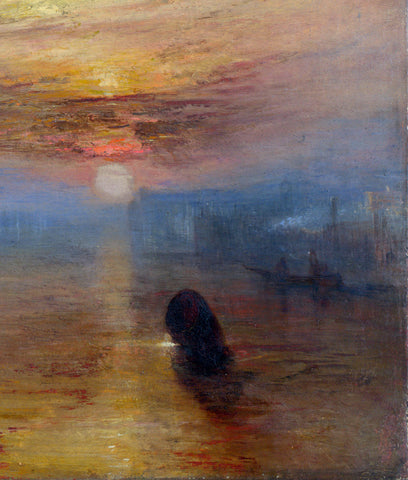
image: the Fighting Temeraire background detail
The Fighting Temeraire In Popular Culture
In the 2012 James Bond film Skyfall, the painting serves as a symbol of Bond's age and status within MI6.
In February 2020, the Bank of England released a new polymer £20 note featuring Turner's 1799 self-portrait, with The Fighting Temeraire depicted in the background. The note also includes the quote "Light is therefore colour" from Turner's 1818 lecture and a reproduction of his signature from his will.
Additionally, the painting inspired the "Glowing Painting" found in the 2020 Nintendo series Animal Crossing: New Horizons.
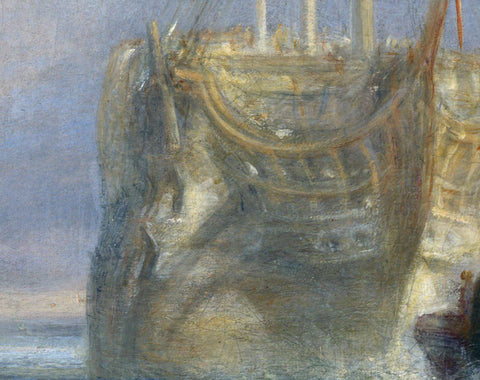
image: close up of the Fighting Temeraire
Frequently Asked Questions about "The Fighting Temeraire" Painting by J.M.W. Turner
Q1: Who painted "The Fighting Temeraire" and when was it created? Answer: "The Fighting Temeraire" was painted by Joseph Mallord William Turner in 1838.
Q2: What does the painting depict? Answer: The painting depicts the HMS Temeraire, a warship from the Battle of Trafalgar, being towed by a steam tugboat up the Thames River to be broken up for scrap.
Q3: Why is this painting significant in art history? Answer: "The Fighting Temeraire" is celebrated for its symbolic representation of the transition from sail to steam power during the Industrial Revolution, reflecting themes of technological advancement and nostalgia for the past.
Q4: Where is the painting currently located? Answer: The painting is housed in the National Gallery, London.
Q5: What artistic techniques did Turner use in this painting? Answer: Turner utilized meticulous brushwork, vibrant colors, and atmospheric effects to create a dramatic and poignant composition. His use of light and shadow is particularly noteworthy.
Q6: What is the story behind the painting's title? Answer: The ship, HMS Temeraire, was famously known as a "fighting" ship, hence the title "The Fighting Temeraire." It emphasizes the ship's glorious past.
Q7: What does the sunset symbolize in the painting? Answer: The sunset in the painting symbolizes the end of an era, as steam power overtakes sail, reflecting the broader societal shift from traditional to modern technology.
Q8: How did Turner depict the tugboat in the painting? Answer: Turner portrayed the tugboat with a white flag, indicating the ship's sale to a private company, a departure from historical accuracy.
Q9: Has "The Fighting Temeraire" undergone any restoration? Answer: The painting remains in exceptionally good condition, having undergone minimal conservation efforts, primarily removing surface dirt in 1945 and applying a lining in 1963.
Q10: How has the painting influenced popular culture? Answer: The painting has appeared in films, literature, and video games, symbolizing themes of history, change, and technological progress, making it a popular subject in various media.
Related Articles:

